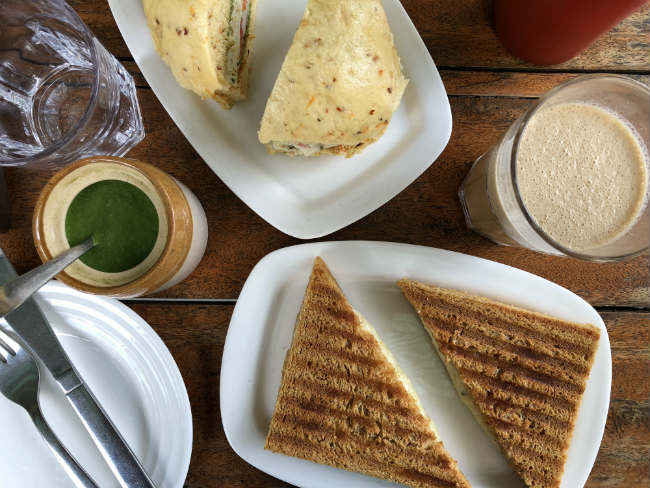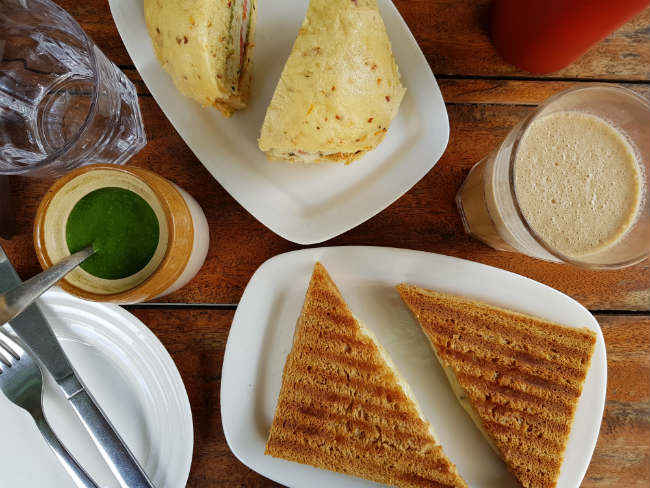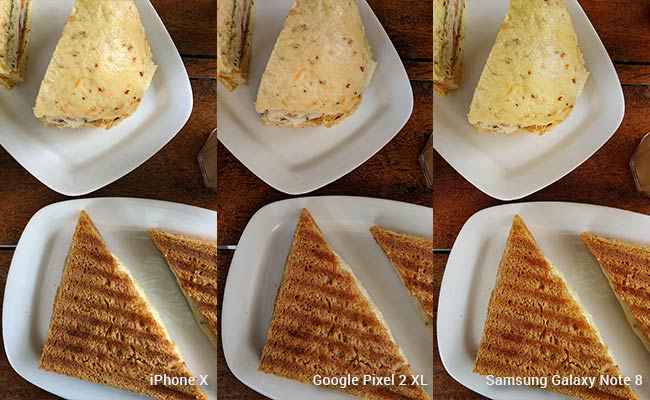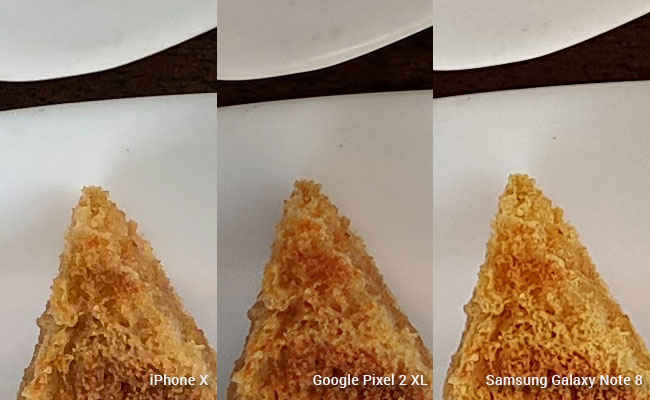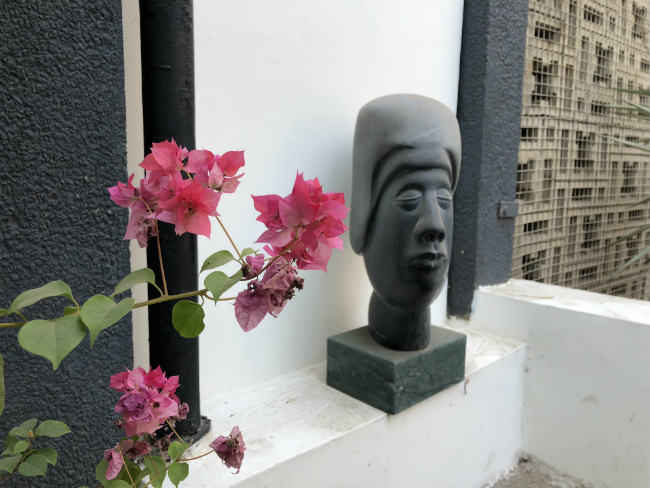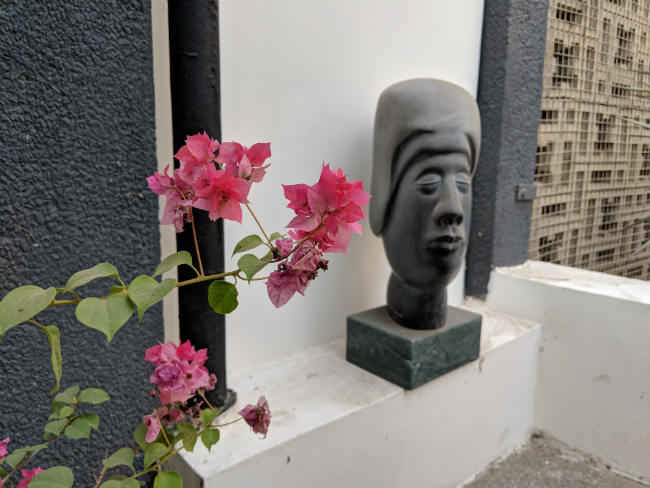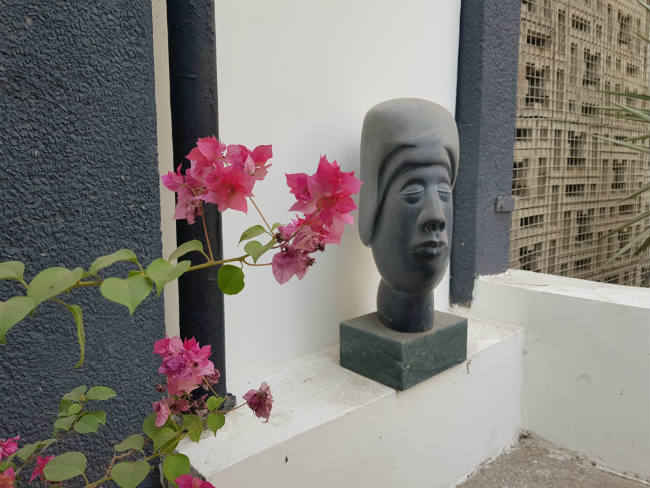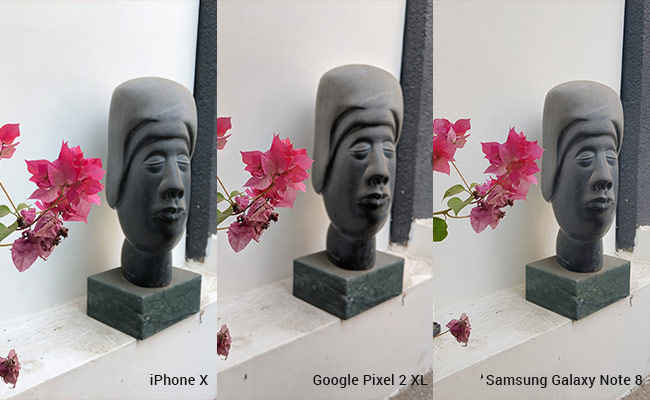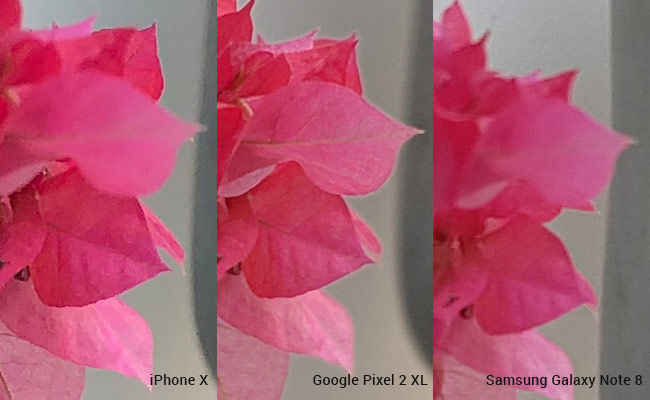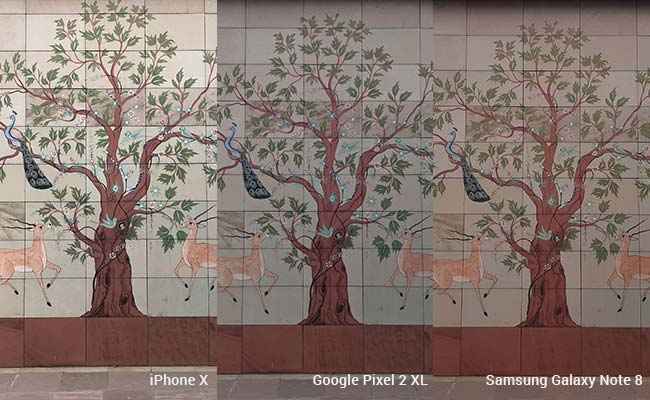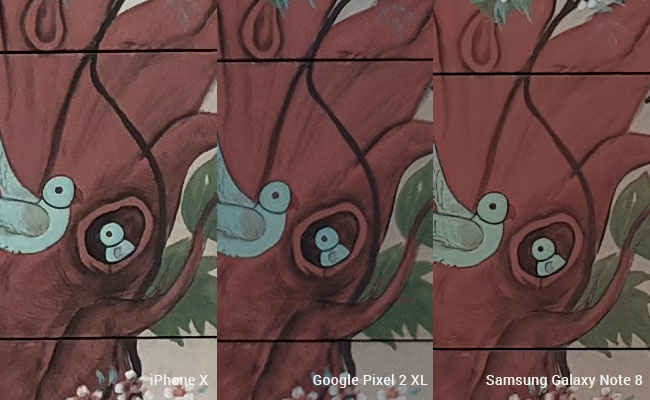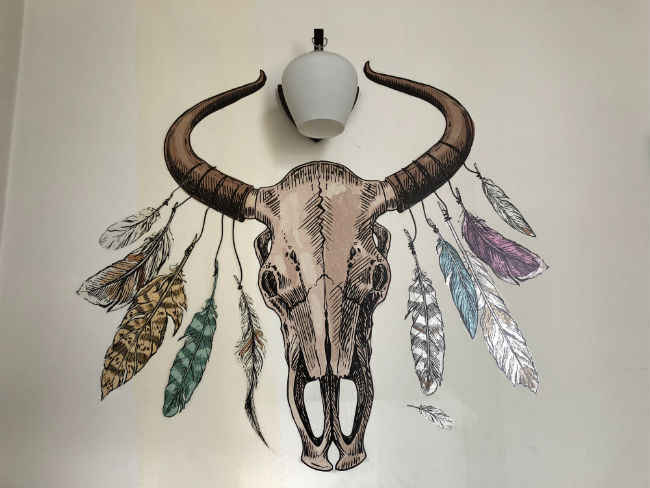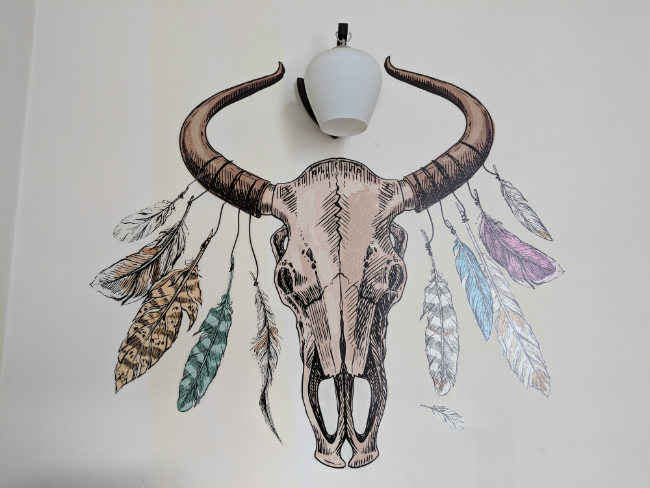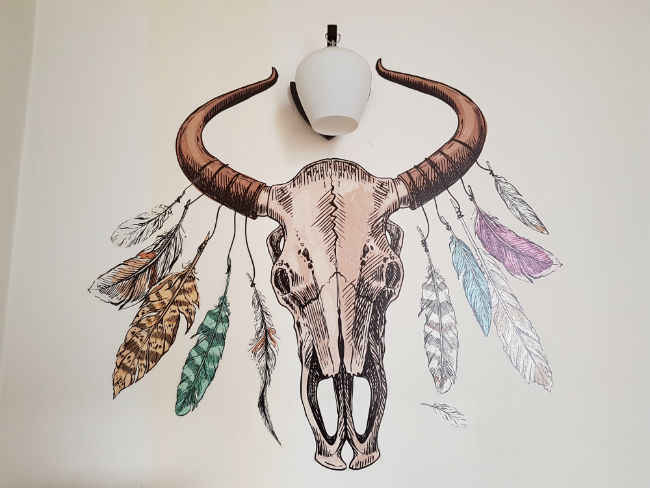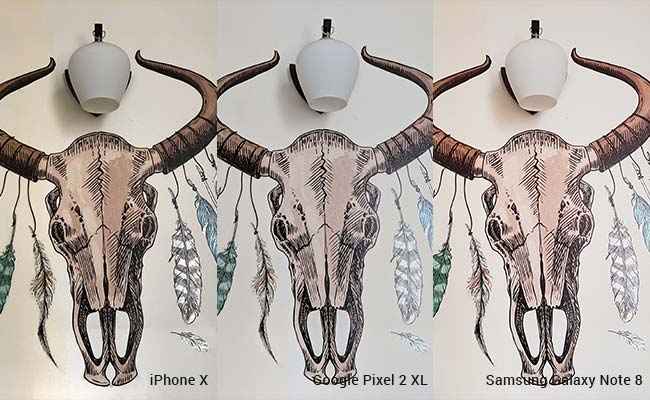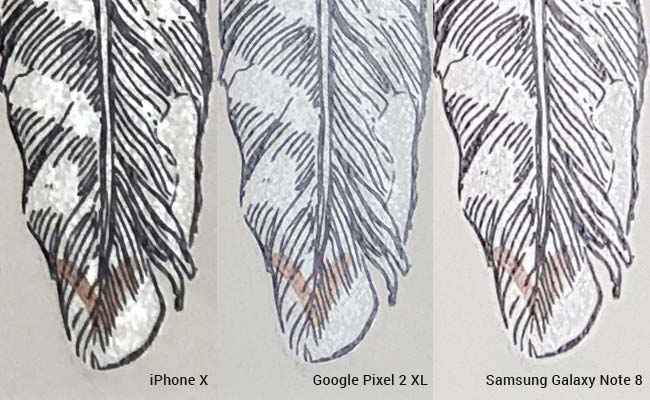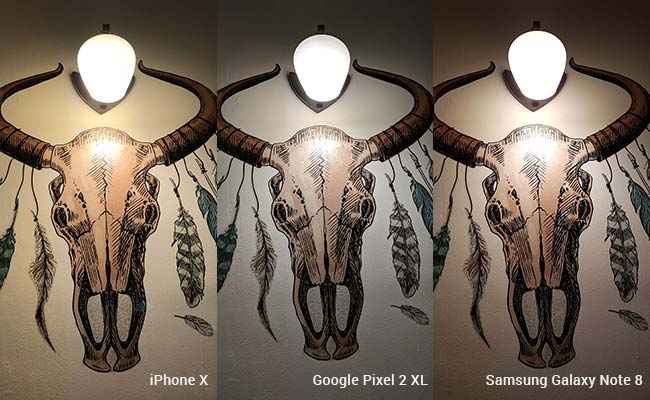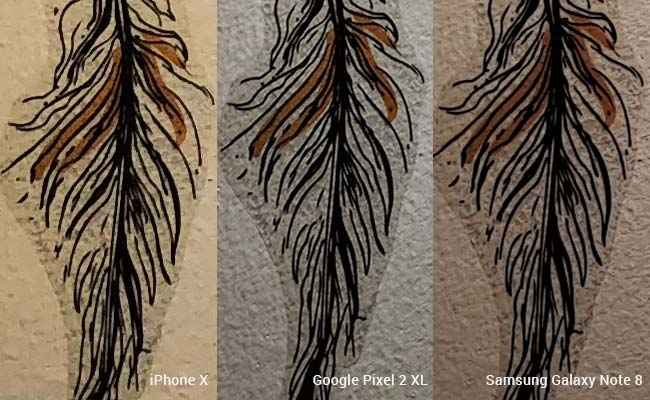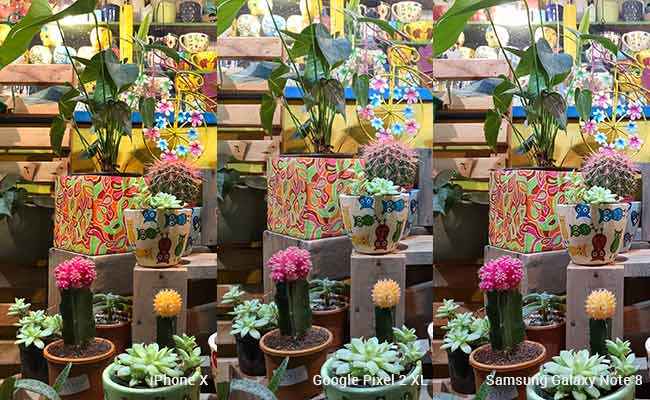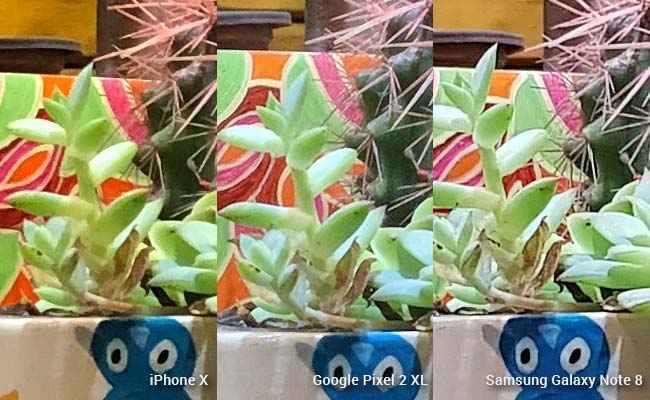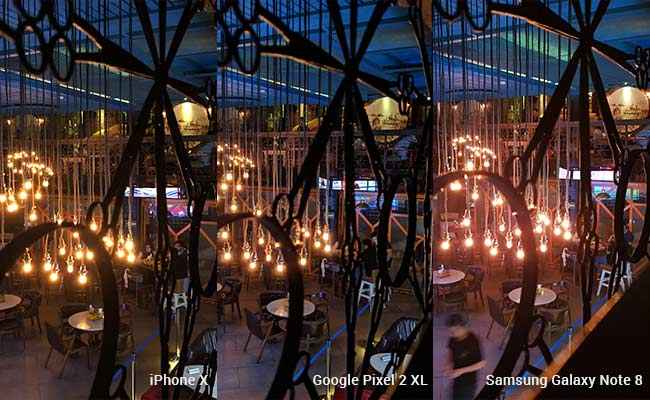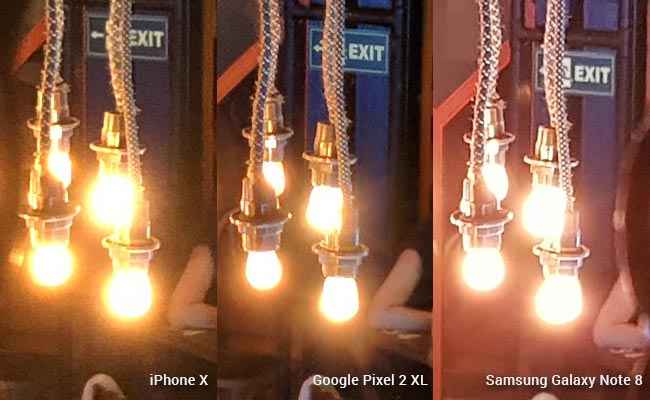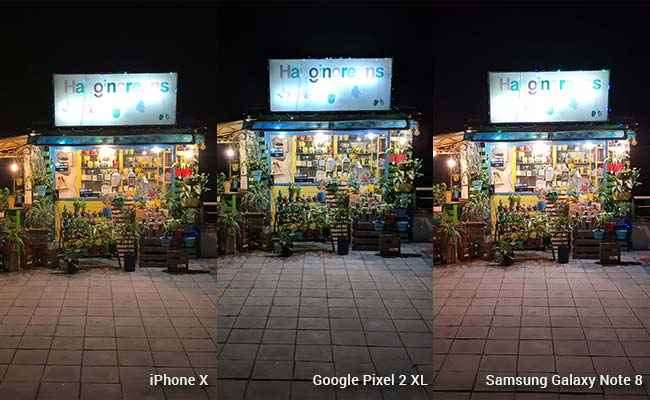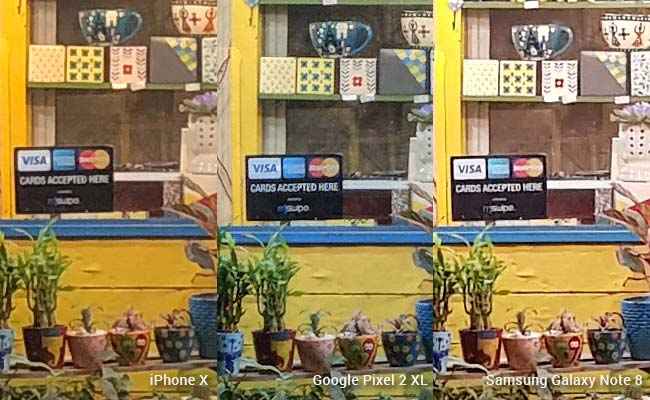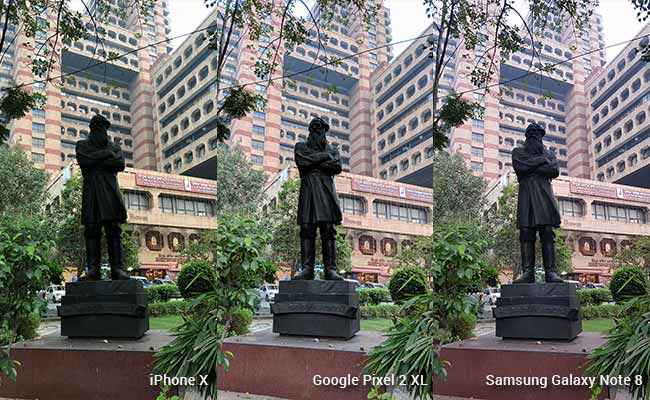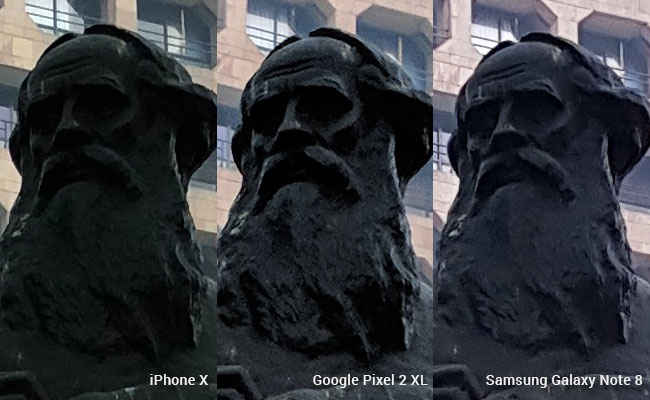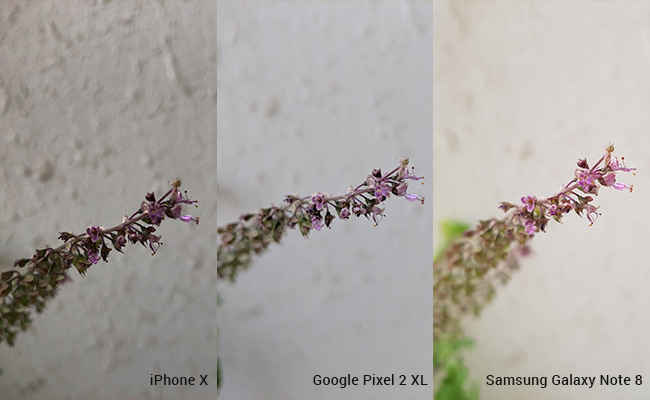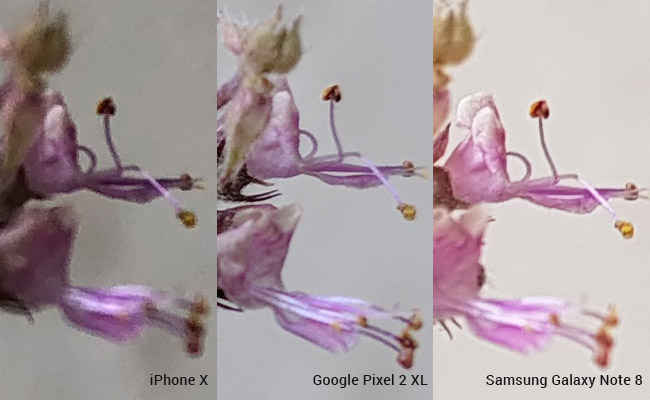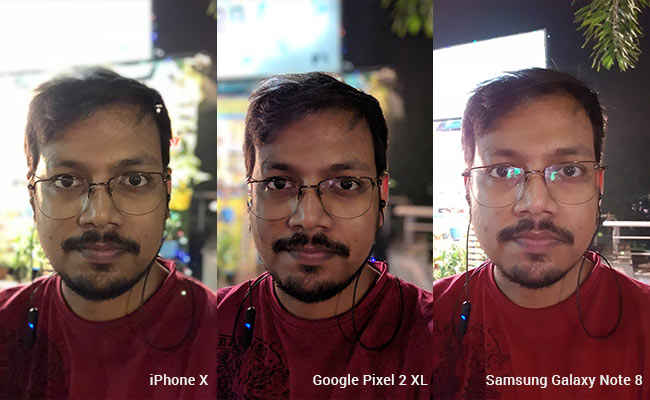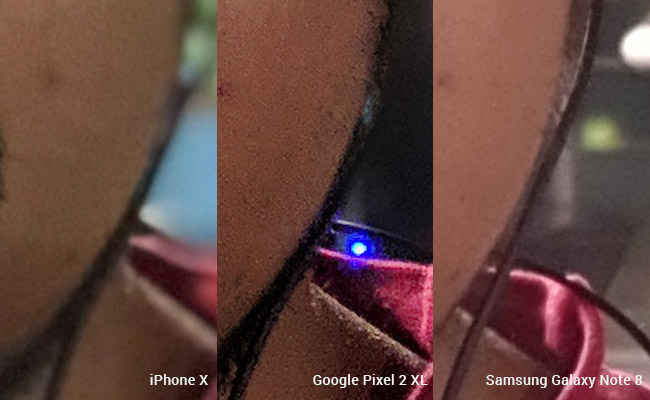Camera comparison: Apple iPhone X vs Google Pixel 2 XL vs Samsung Galaxy Note 8
Together, the Apple iPhone X, Google Pixel 2 XL and Samsung Galaxy Note 8 make for three of the best smartphone cameras today. Their strengths and weaknesses are exposed only when you pit them against each other.
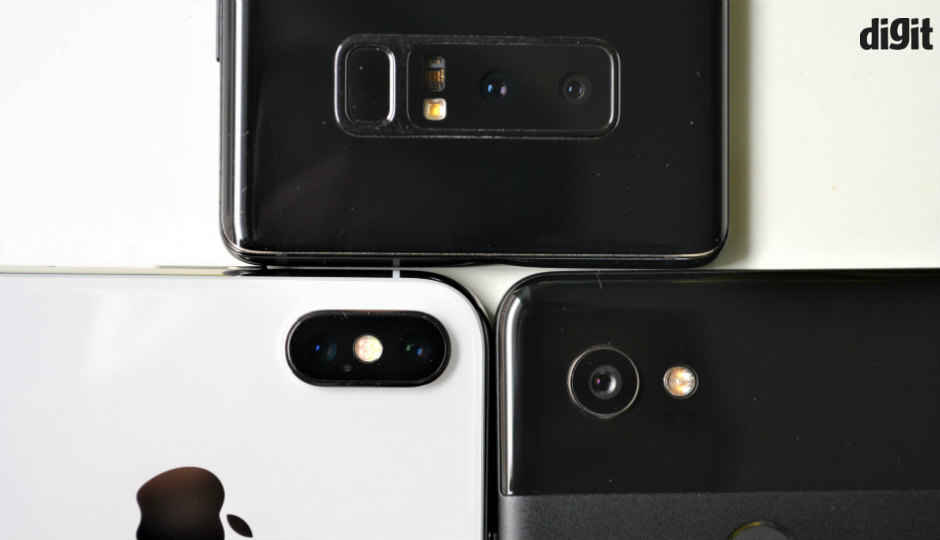
A flagship smartphone is composed of various aspects, that comes together to form a premium experience. The imaging capabilities (or the camera) is clearly one of the most important aspects of a flagship phone today. When evaluating a flagship smartphone’s camera on a standalone basis, it’s easy to get swayed by the high quality performance that it offers across the board. It’s only when you pit the cream of the crop against each other that you unearth the finer differences that make them win or lose against each other. With our camera comparison between the Samsung Galaxy Note 8, the Google Pixel 2 XL and the Apple iPhone X, we aim to do just that. Find which one is worthy of being crowned as the best, while bringing out the strengths and weaknesses of each to give you a clear picture on which one would serve you the best. Do note that we have only focussed on the still image capture capability of the primary (or rear) camera of the three flagships, along with a selfie test. We shall be doing a separate comparison for evaluating the video capture capabilities of the 3 flagships via another comparison.
 Survey
SurveyOn paper:
| Apple iPhone X | Pixel 2 XL | Samsung Galaxy Note 8 | |
| Single / Dual camera | Dual | Single | Dual |
| Resolution (Rear) | 12MP + 12MP | 12.2 | 12MP + 12MP |
| Aperture (Rear) | f/1.8 & f/2.4 | f/1.8 | f/1.7 & f/2.4 |
| Sensor size | 1/3-inch | 1/2.6-inch | 1/2.55-inch |
| Resolution (Front) | 7MP | 8 | 8 |
| Aperture (Front) | f/2.2 | f/2.4 | f/1.7 |
| OIS | Yes | Yes | Yes |
| PDAF | Yes | Yes | Yes |
| Optical zoom | Yes | No | Yes |
| Laser autofocus | No | Yes | No |
Test 1: Food
Social Media is a big part of the lives of millennials. We catalogue moments and things we encounter throughout the day, food being one of them. The test image used here was taken in the morning with plenty of natural light. We observed that the image captured by the iPhone X is more vibrant. It has a better colour saturation and looks more true to source, unlike the rather warm tone reproduced by Samsung Galaxy Note 8. The Google Pixel 2 XL on the other hand offers distinctly better details, but it is unable to offer the same level of colour accuracy as the iPhone X.
Apple iPhone X
Google Pixel 2 XL
Samsung Galaxy Note 8
Apple iPhone X: 5/5
Google Pixel 2 XL: 4.5/5
Samsung Galaxy Note 8: 4/5
Test 2: Fauna
The next subject here is the commonly found pink Bougainvillea flower. The image has been taken in a breezy environment, with the subject swaying slowly making it a little difficult for the cameras to focus. We observed that the Google Pixel 2 XL does a better job in getting focus and details right. The subject looks sharp and background (statue + wall) and foreground (flower) separation is better. The iPhone X still manages to offer better white balance and the Samsung Note 8 captures a vibrant image, but it also sacrifices on details and definition, thanks to a very strong noise reduction algorithm at work. Ideally, with the given light conditions, the Note 8 shouldn’t have been so heavy handed on noise reduction.
Apple iPhone X
Google Pixel 2 XL
Samsung Galaxy Note 8
Apple iPhone X: 4/5
Google Pixel 2 XL: 5/5
Samsung Galaxy Note 8: 3/5
Test 3: Outdoor (overcast conditions)
Here is a perfect example of clicking a picture in overcast conditions. The subject here is the painting on the wall. In this image, it is easier to see the inconsistency in the Pixel 2 XL’s camera, that we discussed in the review. The white balance is off in the image captured by the Pixel 2 XL, there is visible noise and astonishingly, the photo even has lesser details.On the other hand, the iPhone X offers a sharp photo with more details, but at the same time it adds some noise. Samsung’s algorithm waters down noise quite well, but in doing so, it decreases overall image sharpness. The Note 8 though offers better white balance than the Pixel 2 XL in this photo.
Apple iPhone X: 4/5
Google Pixel 2 XL: 3/5
Samsung Galaxy Note 8: 3.5/5
Test 4: Natural light (indoors)
The Pixel 2 XL is unable to redeem itself in this simple natural light test, but then again none of the cameras have managed to capture the subject properly on this test. Still, Apple takes the lead here, offering better overall image quality, thanks to better white balance and more accurate colour reproduction. The Samsung Galaxy Note 8 manages to reproduce better colours than the Pixel 2 XL, but all three phones end up at almost at par in terms of image details.
Apple iPhone X
Google Pixel 2 XL
Samsung Galaxy Note 8
Apple iPhone X: 3.5/5
Google Pixel 2 XL: 2/5
Samsung Galaxy Note 8: 3/5
Test 5: Incandescent light (indoors)
This is the same subject taken in incandescent light and one can see Google’s new camera algorithm working overtime here. The image by the Pixel 2 XL looks sharp and it’s more true to source. The phone captures plenty of details though white balance is still not spot on, it is better than the other two contenders. The Note 8 offers better details than the iPhone X, but then ends up with a similar score as the X, losing out on colour accuracy. Which the iPhone X seems to be consistently good at.
Apple iPhone X: 4/5
Google Pixel 2 XL: 4.5/5
Samsung Galaxy Note 8: 4/5
Test 6: Outdoors under incandescent light
We took this image late at night, under bright incandescent lighting. The Google Pixel 2 XL loses out here, just because of low colour accuracy. The Samsung Galaxy Note 8 and the iPhone X at least try to retain the colours. The iPhone X takes the lead as colours are more true to source. There is some noise in all images, but details are still best preserved by the Google Pixel 2 XL.
Apple iPhone X: 4/5
Google Pixel 2 XL: 3/5
Samsung Galaxy Note 8: 3.5/5
Test 7: Low light 1
In this low light shot, it is quite visible that the colour reproduced by Samsung’s Galaxy Note 8 are not true to source. The low light algorithm used by the Samsung phone induces a red hue to the image, which sets it below the other two contenders. On the other hand both the Google Pixel 2 XL and Apple iPhone X do a better job here. Both phones capture details quite well, even when it is taken against the light. The Pixel 2 XL however inches ahead of the iPhone X with a slightly sharper image and deeper colors.
Apple iPhone X
Google Pixel 2 XL
Samsung Galaxy Note 8
Apple iPhone X: 4.5/5
Google Pixel 2 XL: 5/5
Samsung Galaxy Note 8: 3/5
Test 8: Low Light 2
We observed the same results in this second low light image. The Pixel 2 XL not only manages to offer more true-to-source colours, but also keeps finer details intact. The iPhone X image may look better from the layman’s perspective here, offering a slightly warmer tone that many like. However, like the image taken by the Note 8, it has less details and inferior colour accuracy.
Apple iPhone X: 4.5/5
Google Pixel 2 XL: 5/5
Samsung Galaxy Note 8: 4/5
Test 9: Dynamic range
In this test, we wanted to know if the camera can capture subjects with usable details when the background is brighter in contrast. Here, Google’s camera is better than the iPhone X, offering a visible, sharper and detailed subject (statue) against the bright background (building). Samsung also manages a better photo in this test over the iPhone X, offering a more visible subject. However, in doing so Samsung offsets the white balance in the image, again adding that warmer hue we saw during the low-light tests.
Apple iPhone X: 4/5
Google Pixel 2 XL: 4.5/5
Samsung Galaxy Note 8: 4/5
Test 10: Macro
Macro images are the best kind to showcase a camera’s prowess and in this image we have taken an image of a flower cluster of the Holy Basil, commonly known as Tulsi. The flowers are no more than a centimetre in size and this whole cluster shown in the image is less than 5 cm in size. Still, the Google Pixel 2 XL manages to click a superb image. There are plenty of details and colours are accurate, while you also get perfect background separation.
In contrast, the Apple iPhone X ends up with a less detailed image than either of the two contenders, which has visible noise as well. The image does look good as a whole, especially on a mobile screen, but as soon as you put it up on a larger display, the minor differences are quite visible. Lastly, the Galaxy Note 8 is slightly better than the iPhone X in overall details. The image is brighter, which looks good, though the colors are not true to source.
Apple iPhone X: 4/5
Google Pixel 2 XL: 5/5
Samsung Galaxy Note 8: 3.5/5
Test 11: Selfie
Taking a portrait image in low light and against the light is any front facing camera’s nightmare. That being said, Google’s Pixel 2 XL nails it like a champ. However, the image captured is not perfect. You can still see that the headphone wire going in the ear has been chopped off in order to provide that blurred ‘bokeh’ background. But it is still the best image among the three.
Google’s camera algorithm manages to perfectly separate the foreground and background, almost like a DSLR camera. The selfie taken by the Apple iPhone X here is clearly a few steps behind. The image is not as sharp, less vibrant and the foreground and background separation is not as good as the Pixel’s. Samsung’s Note 8 does not have a portrait mode on the front camera and hence comes in last of the three.
Apple iPhone X: 3/5
Google Pixel 2 XL: 5/5
Samsung Galaxy Note 8: 3/5
Scores:
Google Pixel 2 XL: 46.5
Apple iPhone X: 44.5
Samsung Galaxy Note 8: 38.5
| Apple iPhone X | Pixel 2 XL | Samsung Galaxy Note 8 | ||
| Sample 1 | 5 | 4.5 | 4 | Food |
| Sample 2 | 4 | 5 | 3 | Fauna |
| Sample 3 | 4 | 3 | 3.5 | Wall art |
| Sample 4 | 3.5 | 2 | 3 | Indoor natural light |
| Sample 5 | 4 | 4.5 | 4 | Indoor incadecent light |
| Sample 6 | 4 | 3 | 3.5 | Resolution |
| Sample 7 | 4.5 | 5 | 3 | OIS |
| Sample 8 | 4.5 | 5 | 4 | PDAF |
| Sample 9 | 4 | 4.5 | 4 | Dyanmic range |
| Sample 10 | 4 | 5 | 3.5 | Macro |
| Sample 11 | 3 | 5 | 3 | Front camera |
| Total | 44.5 | 46.5 | 38.5 |
Final thoughts
The Google Pixel 2 XL wins our shootout, though the gap against the iPhone X is marginal, while the Note 8 becomes a clear third. However, the Pixel 2XL is not the fastest, especially when it comes to portraits. It takes the image instantly without any shutter lag, but one cannot see the end result immediately as post processing is done in the background and takes a second or two to finish. The iPhone X is the fastest of the lot in terms of focussing and capture, though it seems to have dialed down a bit on the details and definition level, with its (Apple’s) newly found love for heavier noise reduction. Where iPhone X scores however is the consistency in white balance and color accuracy departments. The Samsung Galaxy Note 8 while being good in low-light (specially in terms of delivering bright images in low light scenarios), ends up making significant sacrifices on details and uses heavy image enhancement algorithms that often takes away the natural tone and balance of the image.
However, we’d once again like to remind you that we are looking at the absolute top of the crop flagships and while weaknesses and strengths are exposed in comparison to each other (which was the purpose of this shootout), on absolute terms, each of these smartphones offer stellar cameras that are head and shoulders above mid-range smartphone cameras. And, you will not really have any complaints against any of these in terms of still image capture quality, as long as you are aware of their strengths and weaknesses.
Hardik Singh
Light at the top, this odd looking creature lives under the heavy medication of video games. View Full Profile
